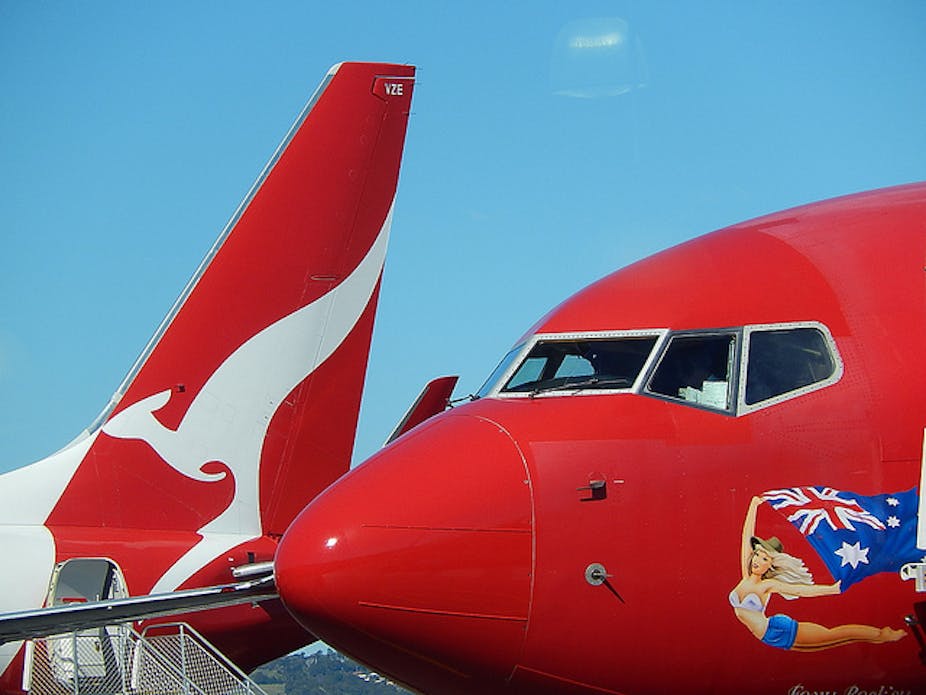The most recent round of what is presented in Australia as a battle for supremacy in a two-horse race saw Qantas and Virgin Australia revealing their annual results. Qantas reported a net profit for the year of around $6 million accompanied by a cautiously optimistic forward outlook. After last year’s $245 million loss, this result is certainly worth cheering about.
This report must have been particularly pleasing for Qantas CEO Alan Joyce when, the day after, Virgin Australia posted a net loss of $98 million, down from a net profit of $23 million in the previous year. However, the battleground on which these two face up is not easily defined with clear boundaries. It is not just the core business of flying that delivers financial results, as demonstrated by Qantas’s earnings from its Frequent Flyer program. Also, in the global air travel context, there are factors other than financial results that will determine future winners and losers.
On internal flights, the two airlines dominate the national network with very similar profiles and offerings that have converged over recent years. Virgin has moved up-market with new business offerings both on the ground and in the air, while Qantas has increased its low-cost offerings, largely through its Jetstar brand.
The example of the Melbourne-Perth route shows how the two compete on very similar terms. However, even in the domestic arena this is not entirely a two-competitor field, particularly in financial terms. Australia’s most profitable domestic airline in the past year was Regional Express (Rex) with a net profit of $14million. This result is a 45% drop on the previous year and comes with warnings of unpredictable times ahead from Executive Chairman Lim Kim Hai.
If the domestic market is uncertain in the current economic and political climate then the international market is certainly even less predictable. Here, the Qantas versus Virgin battle unfolds in a crowded market with many interesting challengers to consider. Both airlines operate internationally with their own flight schedules and through partnership and code share arrangements with other airlines.
Qantas attributes a major turnaround in its international losses to its tie-up with Emirates earlier this year, moving its major hub for European links from Singapore to Dubai. Virgin has a partnership with Etihad linking through the latter’s Abu Dhabi hub. Of course, both Emirates and Etihad fly their own aircraft into Australia and so compete with their partners.
Both Emirates and Etihad are examples of a new breed of international airline that has grown rapidly to challenge the long-established carriers. Emirates made its first regional flights in 1985 with just two aircraft. Etihad has only existed since 2003. However, both benefit from major home investment in their hub airports and their aircraft fleets. Also, they are not as dependent upon stock market investors and shareholder confidence as their Australian partners or other competitors.
Alan Joyce makes a point of Qantas overall now having its lowest average aircraft age in the two decades since privatisation at 7.9 years. However, this includes the Jetstar fleet that, with an average age of 5.3 years is considerably newer than Qantas’s own branded fleet, which comes in at 10.3 years average vintage. As Qantas refits its aging Boeing 767 aircraft and unveils new interiors for its fleet of Airbus A330s, the group has directed its new Boeing 787 Dreamliners to the Jetstar brand.
Virgin Australia currently has a fleet of 89 aircraft with an average age of 4.3 years, much more in line with the Middle East partners. Emirates has over 200 aircraft, including 32 Airbus A380 Super Jumbos, with an average age of 6.4 years for its fleet. Etihad has 70 aircraft with an average age of 5.1 years. All three make Qantas’s main fleet seem positively geriatric.
The Australian media may be fixated on the Qantas versus Virgin competition as a major battle that has some possible “winner takes all” outcome. However, this parochial view fails to take account of the big picture of a global air travel and transport market that is highly unpredictable and in which there are many players.
On August 30, Air India re-entered the Australian market with its first landings in over 16 years. Its Boeing 787 Dreamliner landed in Sydney en-route from Delhi to Melbourne to establish a new route in what the airline sees as a high potential market.
Chinese carriers are becoming key players on international routes to Australia. China Eastern flies to both Melbourne and Sydney from Beijing, Shanghai and Xian. China Southern recently announced daily flights to be established from Guangzhou to Brisbane. The airline will fly A380s between Guangzhou and Sydney from October this year, linking into the “Canton route” to London.
All of this competition is set in a global air travel market that has many competitors and in which alliances might be less about making friends than about “keeping your enemies closer still”. In the short term, the cost of aviation fuel is highly volatile, conflict in Syria and unrest across the Middle East are major areas of uncertainty, and both business and leisure markets are unpredictable.
Qantas and Virgin must be mindful of each other and of their market position in the competition of the domestic arena. But, their futures will be determined within a global arena in which airline survival and success is determined by a vast array of economic, political, social and environmental factors.

